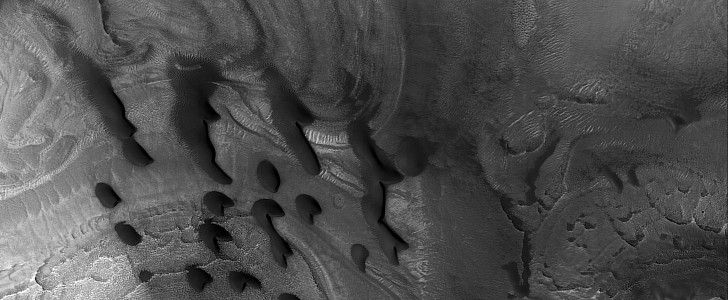After ages of uncertainty, we now know for a fact that there is no sign of existing intelligent life on Mars. Yet one can’t help from thinking about how that might have been, if it ever existed, when images such as the one we have here are released by the people who are constantly surveying the planet.
With the help of the HiRISE camera that has been going around Mars for years now, snapping photos of the place, we got to see things up there we normally wouldn’t have seen, which are now fueling our imagination. Using its fancy filters and other hardware, the HiRISE is not only capable of giving us glimpses of the place in hues we normally don’t expect to see on the Red Planet, but can also create what seems like artificial features.
The black and white image we have here was captured by HiRISE back in 2011, from an altitude of 299 km (186 miles). It shows an area of just 5 km (3 miles) of an impact crater in the Nilosyrtis region of Mars, a place which has “numerous layers exposed along its floor,” formed after the impact.
Those are features one would normally expect to encounter on the planet, and so are the black dunes seen here. Blackened by the HiRISE filters to the extreme, they’re not necessarily curious because of their color, but on account of how organized and artificial even they seem in this processed picture.
The theory is that these dunes were formed after the sand was blown by wind into the region from the surrounding terrain.
Nilosyrtis is a place on our neighboring planet filled with cliffs, mesas, and flat valleys. Scientists believe that sometime in the distant past it was covered by glaciers, hence a large amount of underground ice is likely to still exist under the surface.
The black and white image we have here was captured by HiRISE back in 2011, from an altitude of 299 km (186 miles). It shows an area of just 5 km (3 miles) of an impact crater in the Nilosyrtis region of Mars, a place which has “numerous layers exposed along its floor,” formed after the impact.
Those are features one would normally expect to encounter on the planet, and so are the black dunes seen here. Blackened by the HiRISE filters to the extreme, they’re not necessarily curious because of their color, but on account of how organized and artificial even they seem in this processed picture.
The theory is that these dunes were formed after the sand was blown by wind into the region from the surrounding terrain.
Nilosyrtis is a place on our neighboring planet filled with cliffs, mesas, and flat valleys. Scientists believe that sometime in the distant past it was covered by glaciers, hence a large amount of underground ice is likely to still exist under the surface.







